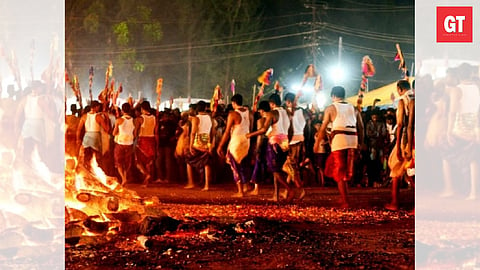

Many are the zatras that are held in various places across Goa, one of the most fascinating being the Shirgao zatra, also known as Lairai zatra, held annually in April or May, in the village of Shirgao, in North Goa’s mining belt. This zatra is held in honour of goddess Lairai (Lahirai), believed be one of the sisters of Our Lady of Miracles (Milagris Saibinn) of Mapusa.
Goddess Lairai is considered to be an incarnation of goddess Parvati and is, thus, treated with much reverence.
ABOUT THE ZATRA
The most interesting feature of this zatra, sometimes called Lairai dhondachi zatra, is the ‘fire-walkers,’ who run on burning coal. On the night of the zatra, over 10,000 dhonds — men and women from all over Goa and the neighbourhood — walk unscathed on a bed of burning charcoal!
At this zatra, a pile of wood is set ablaze, accompanied by the chanting and dancing of the dhonds (fire-walkers), as they invoke the blessings of the deity.
According to local folklore, the danavas (demons) wanted to set fire to Shirgao, in an attempt to destroy, both, Lahirai and her devotees. But, Lahirai and her devotees walked over the fire and extinguished it. The zatra is a remembrance of this, and is an age-old tradition.
To prepare for the zatra, the dhonds follow a strict diet. Those who plan to follow the ritual for the first time have to prepare a month in advance — avoiding meat and alcohol, and spending much time in prayer and penance. Their feet have to be clean and covered at all times since contact with impurities from the ground can result in blistering, or even burning, of their feet during the ritual fire-walk. Some dhonds go to the temple for five days before the zatra, and participate in prayers to the goddess.
On the day of the zatra, after the traditional bath in the water tank, the devotees dance till the deity is taken out in a procession by the priests. The devotees follow the deity to the temple, and after their second bath, partake of prasad before getting ready to walk on the coals.
As the fire-walkers approach the venue, there is the sound of the drums and cymbals. Some dhonds smear themselves with colour and ashes; while others don garlands of mogras along with a zancem (sacred thread) around their necks.
In a trance-like state, dancing wildly, bodies quivering, the dhonds emerge from the temple, following the temple priest, who carries an image of goddess Lairai. The procession eventually reaches the venue, where the fire-walking ceremony takes place. There, a pile of wood is made, consisting of offerings of logs, given by devotees in fulfillment of their vows.
A FIERY WALK
The dhonds circle the pile of wood three times. At midnight, the priest sets fire to the logs. The procession then moves to the fountain for a bath. When the logs burn down to embers, attendants rake them into a bed of live coals, nearly a foot deep and roughly thirty feet long.
Next, the dhonds go to receive the prasad of blessed flowers from the bhat. He tosses a flower onto the live coals. As it shrivels and turns to ashes, he throws in another, until finally, one remains fresh and intact. This is taken as a sign from the goddess that the dhonds are found pure and can safely enter the fire, unscathed. Singing loudly, they walk bare-footed in rows of threes or fours. Some run across, while others take long leaps or walk leisurely or dance and throw their hands up in the air.
Agnidivya (ritual of walking on live embers) will be held at dawn on Friday, May 6, 2022, while ‘kaulotsav’ will be held from May 6, 2022 to May 9, 2022